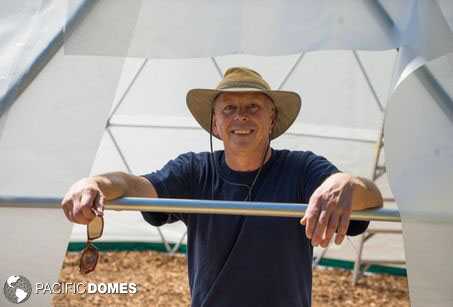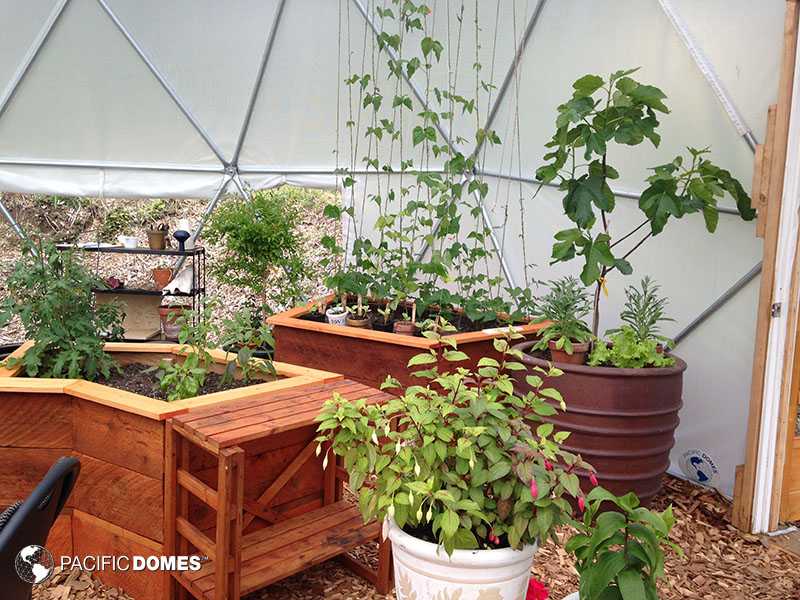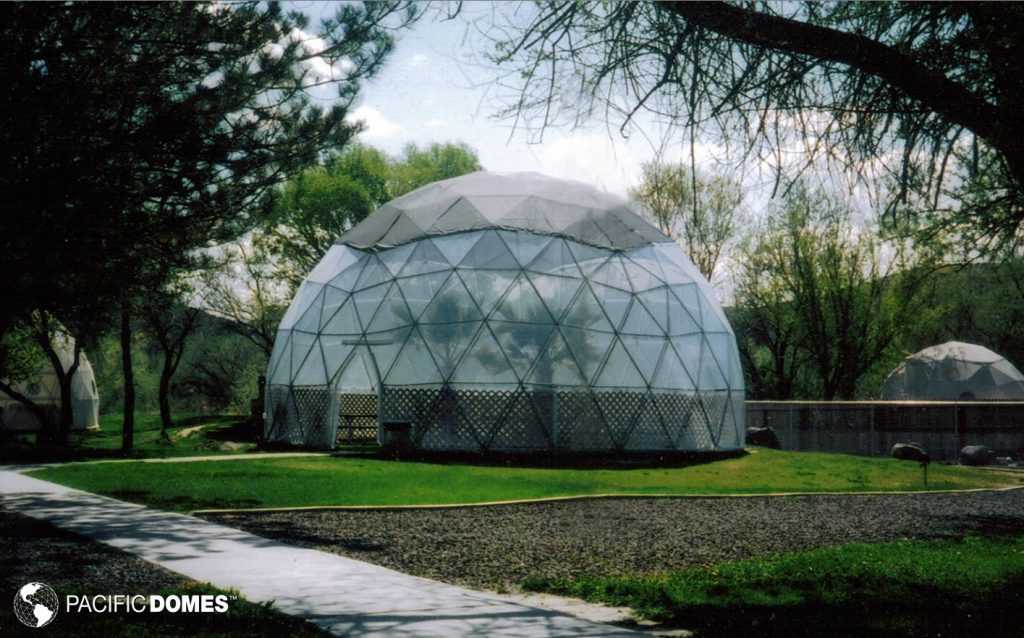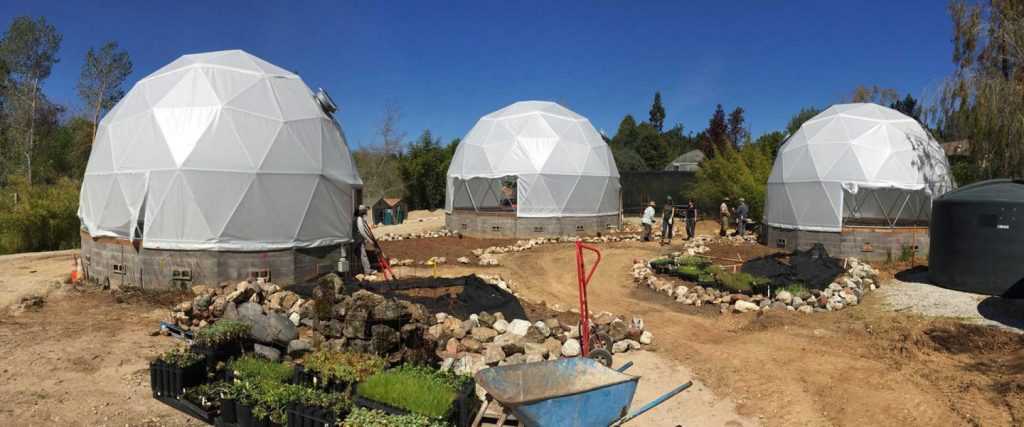“Grow your own food all-year round with an easy-to-assemble GrowDome kit.” — Pacific Domes
Are you looking for an easy-to-assemble backyard greenhouse kit that won’t break the bank or fall apart when Mother Nature decides to unleash her unpredictable weather? You’ve come to the right place to explore why four-season food production GrowDomes have earned the reputation for being an insurance policy in themselves – and, why it’s considered your best long-term investment.

You’ll love that a Greenhouse GrowDome is portable and easy to set-up. And, you’ll love that it can be up and running in no-time, no matter what the weather is doing outside – even, in the dead of winter.
Why do People Buy Greenhouse Kits?
Many regions on the planet don’t provide year-round growing conditions conducive to plant growth. Ideally, a four-season food production environment supplies plants with the five elements they need to thrive: optimal sunlight, air-flow, temperature, moisture and nutrients.
Typically, commercial growers and backyard gardeners alike invest in greenhouses to extend their growing season. Greenhouses not only extend your local growing season, they also provide shelter for your plants to grow without your having to worry about invasive garden pests or critters. That said, the reason many people choose DIY greenhouse kits over building their own is because it saves time and ends up costing less.
Maximizing Food Production
A well-constructed four-season greenhouse creates a microclimate that protects plants from hot summers and cold winters – allowing you to maximize food production all year round.

When choosing a greenhouse kit, you’ll want to consider your local climate, the types of plants you want to grow, and your long-term gardening goals to determine which kit is most suitable for your needs and budget. If you’ve been exploring the web for greenhouse kits, you’ve likely been quick to discover that not all prefab greenhouses are designed to offer 4-season food production.
Conventional greenhouse packages such as the more expensive, open-span quonset-hut and gothic-arch greenhouses used by many commercial greenhouse growers take up larger spaces. They also require elaborate growing systems that backyard gardeners might not consider as practical and cost-effective. In comparison, the clear-span GrowDome provides maximum backyard growing space and an optimal micro-climate biodome for plants – it’s an affordable option, too.
GrowDomes vs. Inexpensive Greenhouse Kits
It’s easy to get overwhelmed by the wide variety of styles and sizes available in today’s marketplace. The main distinction between an inexpensive backyard greenhouse kit and a four-season GrowDome kit lies in their design, materials, features and initial cost.
To help you along your purchasing journey let’s explore some key differences that you’ll want to be aware of:
Construction and Materials
Inexpensive Backyard Greenhouse Kit: Frames are typically made using lightweight materials such as PVC or aluminum that may need additional anchoring or support. Covers are made from polyethylene film or thin-wall panel construction that likely won’t be as durable or provide adequate insulation. Additionally, inexpensive greenhouse kits often lack ample growing space to adequately provide the five elements plants need to thrive.
Four-Season GrowDome Kit: Frames, aka ‘struts’, are manufactured from high-strength US galvanized steel. Greenhouse covers meet industry standards to provide better insulation, durability and resistance to harsh weather conditions. Many clients opt to install a stem wall around their GrowDome. This raises the freestanding structure several feet above the ground to allow for raised bed gardens – while, increasing head-room along the perimeter walls.
Insulation
Inexpensive Backyard Greenhouse Kit: May not have sufficient insulation for maintaining consistent temperatures during hot or cold seasons. This could limit the types of plants that can be grown in less than moderate climates.
Four-Season GrowDome Kit: Offers better insulation and an ergonomic, energy-efficient design that retains ambient temperatures. This allows for comfortable year-round gardening, even in colder climates, while providing a stable biodome environment for a wider range of plants.
Ventilation and Cooling
Inexpensive Backyard Greenhouse Kit: May have limited or basic ventilation options, which could lead to overheating in warmer weather.
Four-Season GrowDome Kit: Options for customized ventilation, automated systems such as solar roof vents, louvers. This helps regulate temperature and prevent overheating during the summer months.
Snow and Wind Load Capacity
Inexpensive Backyard Greenhouse Kit: May not be designed to hold up to the elements and weather extremes – they won’t withstand heavy snow loads or strong winds.
Four-Season GrowDome Kit: Geodesic-engineered strength makes them suitable for regions with harsh weather conditions – built to handle heavy snow loads and high wind speeds.
Size and Shape
Inexpensive Backyard Greenhouse Kit: Often available in smaller sizes and simpler designs but limited in growing space.
Four-Season GrowDome Kit: Available in a variety of sizes, including commercial sizes. Customization options allows for more flexibility in choosing a greenhouse that suits your specific gardening needs. Ample growing space lends a variety of design options that are only limited by your imagination.
Permitting
Inexpensive Backyard Greenhouse Kit: Will the greenhouse kit meet engineering requirements for your local area – or perhaps, require an engineering stamp?
Four-Season GrowDome Kit: Exceeds engineering requirements for greenhouse permitting.
We invite you to follow along as we take a deeper dive into GrowDome Uses, Benefits and Features
GrowDome Uses
GrowDomes have a wide range of residential, commercial and educational applications. Pacific Domes builds prefab Greenhouses and GrowDome Kits that are energy-efficient and ideal for vertical towers, aeroponics, aquaponics and hydroponics. Their uses include schoolyard education, farm-to-table restaurants, urban backyard gardens, off-grid homesteading, prepping and much more.

How does one put a dollar value on the satisfaction that comes from harvesting an abundance of pesticide-free food from your own backyard? As more and more consumers look around at empty produce sections, it’s now becoming more evident than ever that adopting a self-reliant spirit of growing your own food is the answer to family food security.
5 GrowDome Benefits to Consider
The sphere-like GrowDome design creates a naturally occurring biome capable of absorbing, storing and radiating heat in a passive solar growing environment, similar to that of planet earth. With a little help from both modern and ancient growing practices, you can build your own economical and thriving greenhouse micro-climate.
Strength: Arguably, the most obvious benefit is a dome’s superior strength, Geodesic domes have been erected worldwide due to their inherent architecture and ability to withstand the forces of nature.
GrowDomes are an insurance policy in itself! Geodesic-engineering enables domes to withstand high winds and heavy snow loads – as well as, extreme temperatures, tornadoes and earthquakes.
- GrowDome frames are manufactured in the USA using high-strength galvanized steel – they are a lifetime structure.
- Durable SunShield fabric covers will exceed their expected lifespan of 12-20 years with proper care. They scatter diffused light throughout the entire growing space to optimize sunlight for passive solar heating and optimal plant growth – making them ideal for off-grid living.
Sustainability: The second important benefit to consider is that GrowDomes are perfectly suited to environmentally sensitive areas. Exerting a light eco-footprint, prefab GrowDomes come in several portable sizes that can be assembled quickly with basic hand-held tools – and, without the use of heavy construction equipment.
Spaciousness: Buckminster Fuller discovered the doing more with less principle, in that the dome encloses the largest volume of interior space with the least amount of surface area, thus saving on materials and cost. Bucky Fuller reintroduced the idea that when a sphere’s diameter is doubled, it will quadruple its square footage, producing eight-times its volume.

Dome design encloses the largest volume of interior space with the least amount of surface area. The dome’s energy-efficient clear-span construction allows for ambient air and energy to circulate freely without obstruction – thus, enabling heating and cooling to occur naturally.
Energy Efficiency: According to the Buckminster Fuller Institute, geodesic domes’ concave interior “creates a natural airflow that allows the hot or cool air to flow evenly throughout the dome with help from return air ducts. Extreme wind turbulence is lessened because winds that contribute to heat loss flow smoothly around the dome. Additionally, the spherical dome shape acts like a type of giant downward reflector, concentrating interior heat and preventing radiant heat loss.”
Geodesic Architecture: Extensive research into bio-geometrical shapes has rendered scientific conclusions that the energetic qualities of geodesic architecture produces the highest vibrational environment that’s beneficial to both humans and healthy plants.

Many clients opt to install a stem wall around their GrowDome. This raises the freestanding structure several feet above the ground to allow for raised bed gardens – while, increasing head-room along the perimeter walls.
Bonus Tip: Greenhouse GrowDome Mycoculture
One of the challenges of growing in enclosed systems lies in balancing the exchange of gases between its ecosystem and atmosphere – notably, oxygen and carbon dioxide. Pacific Domes has joined the growing ranks of supporters championing the research work of “Mycofiltration” and “Mycoremediation” pioneered by world renowned, mycologist, Paul Stamets and research institutes like JADAM. Thanks to the many trail-blazers who have studied Nature’s blueprint, we are forging a new era of commitment to integrating the innate Intelligence found in Nature’s self-sustained ecosystems through earth-based science.
- Mycoremediation is the cultivation of mushrooms to assist with restoration, replenishment and remediation of overburdened ecosystems.
- Mycofiltration involves the use of mycorrhizal fungal mats as biological filters.
Expanding on the synergetic principles originated by R. Buckminster Fuller, Pacific Domes has been working on perfecting the function and beauty of their portable geodesic domes for more than 40-years in Ashland, Oregon. Pacific Domes has pioneered sustainable living, personal and cultural transformation, and peaceful social evolution since 1980. This means… environmentally aware and sustainable.

Ready to Explore More with
“The Basic Guide to Choosing Your Best Greenhouse Kit”?
